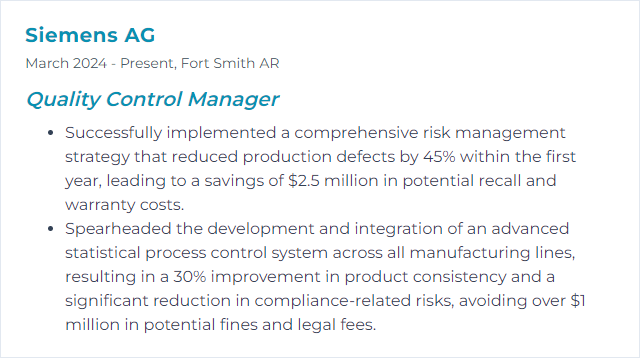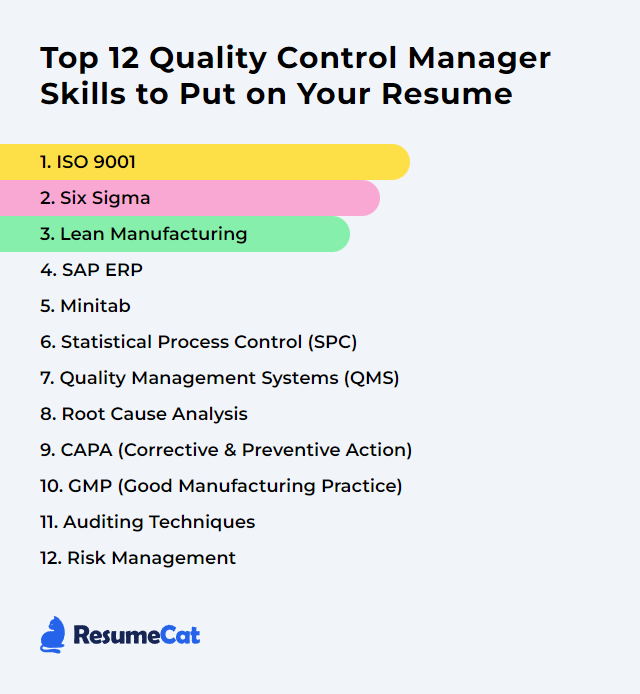Top 12 Quality Control Manager Skills to Put on Your Resume
Quality control managers work in crowded waters, and the resume is their lighthouse. Sharp, proven skills change the odds. The twelve below carry weight with hiring teams and tell a story of rigor, speed, and control.
Quality Control Manager Skills
- ISO 9001
- Six Sigma
- Lean Manufacturing
- SAP ERP
- Minitab
- Statistical Process Control (SPC)
- Quality Management Systems (QMS)
- Root Cause Analysis
- CAPA (Corrective and Preventive Action)
- GMP (Good Manufacturing Practice)
- Auditing Techniques
- Risk Management
1. ISO 9001
ISO 9001 defines what a robust quality management system should look like. It sets requirements that help an organization consistently meet customer and regulatory needs and get better over time. The current edition is ISO 9001:2015 with a 2024 amendment emphasizing climate-related considerations.
Why It's Important
It anchors consistency. It weaves risk-based thinking into daily work. It lifts customer satisfaction, keeps audits calm, and drives continual improvement instead of one-off heroics.
How to Improve ISO 9001 Skills
Level up with practical, visible habits:
- Leadership in action: Secure real executive ownership. Publish quality objectives, review them, resource them, and remove roadblocks.
- Customer focus: Close the loop on complaints, returns, and surveys. Build a cadence to analyze themes and act.
- Process approach: Map key processes, their inputs, outputs, owners, and interactions. Use PDCA to tune them.
- Risk-based thinking: Identify top risks and opportunities for each process. Prioritize controls and measure effectiveness.
- Competence and awareness: Train with purpose. Validate effectiveness, not just attendance.
- Documented information: Keep procedures lean, current, and easy to find. Control records for traceability.
- KPIs that matter: Tie metrics to objectives (on-time delivery, defects per unit, cost of poor quality, audit findings closed on time).
- Supplier control: Qualify, monitor, and develop suppliers with clear criteria and shared improvements.
- Internal audits: Risk-based plans, sharp checklists, objective evidence, and prompt, verified corrective actions.
- Management review: Make it a decision meeting, not a slideshow. Approve actions, owners, and deadlines.
Use the standard as a playbook, not a poster. That’s where maturity shows.
How to Display ISO 9001 Skills on Your Resume
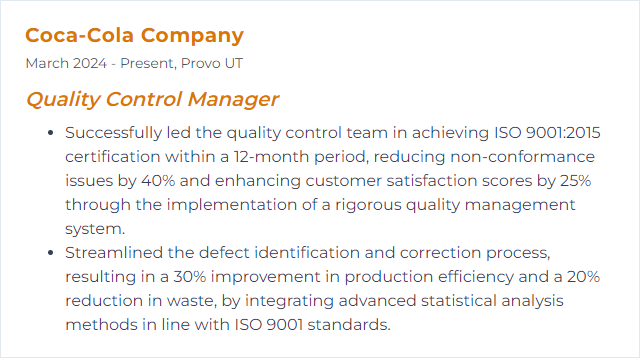
2. Six Sigma
Six Sigma is a data-first method to cut variation and eliminate defects. The DMAIC cycle and a toolkit of statistical techniques push processes toward predictable, stable performance.
Why It's Important
Fewer defects mean lower rework, faster flow, happier customers. It gives a common language to diagnose problems and lock in gains.
How to Improve Six Sigma Skills
- Keep learning: Refresh Green/Black Belt knowledge. Coach belts. Run real projects, not hypothetical drills.
- Pick the right projects: Prioritize high-value pain points with clear problem statements and charters.
- Use strong data: Validate measurement systems (MSA). Garbage in ruins everything else.
- Master the tools: Get fluent with hypothesis tests, regression, DOE, capability, control charts. Practice in software like Minitab or similar.
- Integrate with Lean: Pair variation reduction with waste elimination. Speed and stability together beat either alone.
- Change management: Prepare stakeholders early. Communicate benefits, train users, and plan adoption, not just analysis.
- Voice of the customer: Convert feedback into CTQs and specs. Let customers define “good.”
- Sustain: Build controls, dashboards, and ownership so improvements stick after the celebrations end.
How to Display Six Sigma Skills on Your Resume
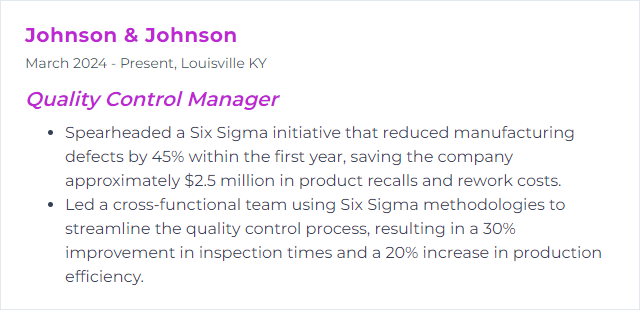
3. Lean Manufacturing
Lean targets waste and flow. It focuses on value from the customer’s eyes and removes everything that doesn’t help deliver it, reliably and fast.
Why It's Important
Less waste, fewer defects, quicker cycles. Better margins without cutting corners. Lean underpins stable quality and calmer operations.
How to Improve Lean Manufacturing Skills
- Kaizen every day: Small, frequent fixes beat rare, grand programs.
- Standard work: Clear, visual standards reduce variation and training time.
- 5S with discipline: Sort, set in order, shine, standardize, sustain. Clutter hides problems.
- Gemba walks: Go see. Ask why. Respect people. Real understanding lives on the floor.
- Value stream mapping: See end-to-end flow, expose bottlenecks, and target lead time.
- SMED and TPM: Faster changeovers, reliable equipment, less downtime, fewer defects.
- Poka‑Yoke: Error-proof steps so mistakes can’t sneak through.
- Visual management: Andon signals, tiered huddles, and simple boards to surface issues instantly.
How to Display Lean Manufacturing Skills on Your Resume
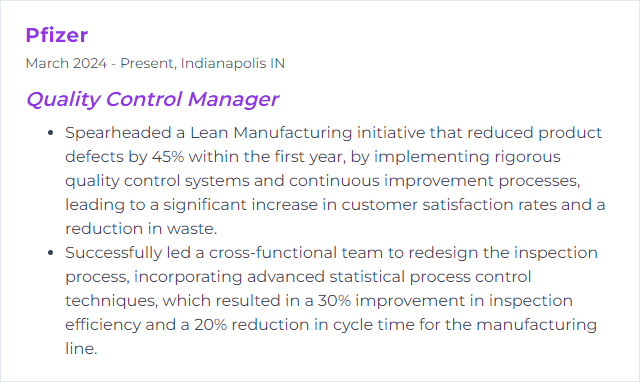
4. SAP ERP
SAP ERP, including SAP S/4HANA, ties finance, supply chain, production, and quality together. The QM module supports inspections, nonconformance management, and continuous improvement with real-time data.
Why It's Important
One system of record. Traceability without the chase. Embedded analytics and workflows that keep quality woven into operations, not bolted on.
How to Improve SAP ERP Skills
- Automate with QM: Inspection plans, sampling, results recording, usage decisions—configure to cut manual entry and errors.
- Master data discipline: Tight control of specs, BOMs, routings, and vendors. Clean master data, clean outcomes.
- Integrate with MES: Close the loop between shop-floor events and ERP quality records for faster decisions.
- Analytics: Build dashboards for defects, cost of poor quality, vendor performance, and effectiveness of actions.
- Electronic records: Enable digital signatures, audit trails, and controlled workflows for compliance.
- Train and document: Role-based training and quick reference guides to accelerate adoption.
- Iterate with users: Collect feedback, refine transactions and screens, and prune unused fields that slow people down.
How to Display SAP ERP Skills on Your Resume

5. Minitab
Minitab is a workhorse for statistical analysis, from control charts to DOE. It helps translate messy data into clear, defensible conclusions.
Why It's Important
Decisions move from gut feel to evidence. You spot signals, not noise. And you can prove it.
How to Improve Minitab Skills
- Solid stats: Refresh distributions, p-values, power, confidence intervals, and practical significance.
- Hands-on practice: Analyze real shop-floor data. Recreate past issues, test new hypotheses.
- Assistant and guides: Use built-in helpers to select the right test and interpret outputs clearly.
- DOE and optimization: Run factorials and response surface designs to find sweet spots quickly.
- Capability nuance: Handle non-normality, short-term vs long-term, and stability before Cp/Cpk claims.
- MSA rigor: Gage R&R, bias, linearity. Fix measurement first.
- Templates/macros: Standardize analyses so teams replicate quality methods consistently.
How to Display Minitab Skills on Your Resume

6. Statistical Process Control (SPC)
SPC watches processes in real time, using control charts and rules to separate common-cause variation from special causes.
Why It's Important
When a process drifts, you catch it early. Less scrap, less rework, more confidence in every unit shipped.
How to Improve Statistical Process Control (SPC) Skills
- Train the team: Charts, rules, rational subgrouping, and proper sampling—make it common knowledge.
- Real-time data: Collect at the point of use. Alerts trigger containment before customers feel it.
- Standardize methods: Clear instructions for where, when, how, and how much to sample.
- Right chart, right job: X‑bar/R, I‑MR, p/np, u/c, EWMA—pick based on data type and behavior.
- Capability with care: Confirm stability before capability. Then align specs with process reality.
- Measurement first: Confirm gage capability. Bad gages fabricate crises.
- Visual and collaborative: Daily reviews at the line. Escalate patterns, not anecdotes.
How to Display Statistical Process Control (SPC) Skills on Your Resume
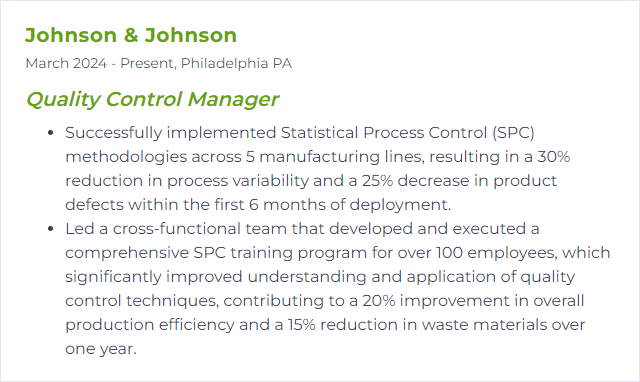
7. Quality Management Systems (QMS)
A QMS is the structure—policies, processes, procedures, and records—that steers quality. It aligns intent with execution and proof.
Why It's Important
Predictable outputs, compliant operations, and a clear path to improvement. It’s how quality becomes a system, not a slogan.
How to Improve Quality Management Systems (QMS) Skills
- Baseline first: Audit the current system. Map gaps against standards and regulations that apply.
- SMART objectives: Focus the system on a handful of measurable outcomes that matter.
- Digital where it counts: eQMS workflows for document control, training, change, CAPA, and audits reduce misses.
- Process ownership: Each core process needs an owner, KPIs, risks, and a review rhythm.
- Training with evidence: Competence, not checkboxes. Verify skills on the job.
- Management review with teeth: Decide, fund, and prioritize. Track action closure.
- Continuous improvement: Embed Kaizen, Lean, and Six Sigma into the QMS backbone.
How to Display Quality Management Systems (QMS) Skills on Your Resume
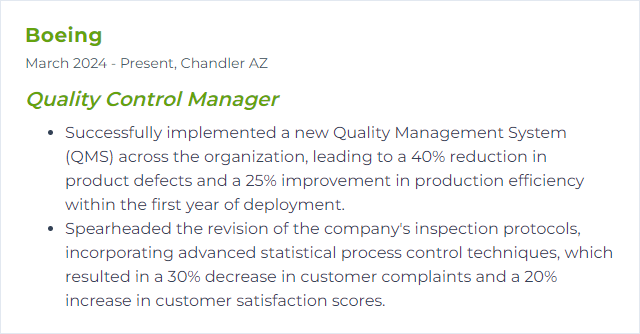
8. Root Cause Analysis
RCA chases causes, not symptoms. It breaks problems open so corrective actions actually prevent recurrence.
Why It's Important
Without true cause, issues boomerang. RCA turns firefighting into fire prevention.
How to Improve Root Cause Analysis Skills
- Define sharply: Clear problem statements—what, where, when, scope, and impact.
- Contain fast: Protect the customer while you investigate.
- Use the right tools: 5 Whys, Fishbone (Ishikawa), Fault Tree, Pareto, FMEA—mix as needed.
- Follow the data: Validate with facts, not hunches. Recreate failures when safe and practical.
- Cross-functional: Bring voices from process, maintenance, design, and supply chain.
- Verify effectiveness: After fixes, measure results and watch for regression.
- Standardize and share: Update procedures, train, and publish lessons learned.
How to Display Root Cause Analysis Skills on Your Resume

9. CAPA (Corrective and Preventive Action)
CAPA is the structured engine that turns issues into permanent fixes and future risk reduction.
Why It's Important
It closes loops. It shows regulators and customers that problems are understood, addressed, and unlikely to return.
How to Improve CAPA (Corrective and Preventive Action) Skills
- Risk-based triage: Prioritize high-severity, high-occurrence issues first.
- Root cause linkage: Tie actions directly to proven causes. No orphan tasks.
- Action clarity: Specific owners, due dates, resources, and expected outcomes.
- Implementation control: Train, update docs, and verify changes actually reached the point of use.
- Effectiveness checks: Define criteria up front. Use data to confirm.
- Trending and signals: Monitor CAPA cycle times, repeat issues, and backlog aging.
- Documentation discipline: Complete, traceable records that stand up to audits.
How to Display CAPA (Corrective and Preventive Action) Skills on Your Resume
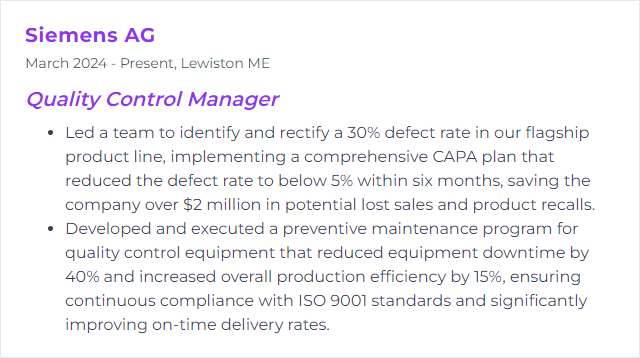
10. GMP (Good Manufacturing Practice)
GMP sets the guardrails for manufacturing—people, processes, premises, and paperwork—so products are safe, consistent, and compliant.
Why It's Important
Testing alone can’t guarantee quality. GMP bakes quality into how work is done, every time.
How to Improve GMP (Good Manufacturing Practice) Skills
- Know the rules: Track current regulatory expectations and guidances relevant to your industry and region.
- Data integrity: Follow ALCOA+ principles (attributable, legible, contemporaneous, original, accurate—and more).
- Training and qualification: Role-based training, qualification, and periodic requalification.
- Validation and qualification: Processes, cleaning, equipment, and computerized systems—planned, executed, and maintained.
- Change control: Evaluate impact, validate when needed, communicate broadly.
- Deviation management: Rapid investigation, root cause, and effective CAPA.
- Supplier and materials control: Qualification, monitoring, and incoming inspections with clear specs.
- Hygiene and environment: Housekeeping, gowning, environmental monitoring, and maintenance that never slips.
How to Display GMP (Good Manufacturing Practice) Skills on Your Resume
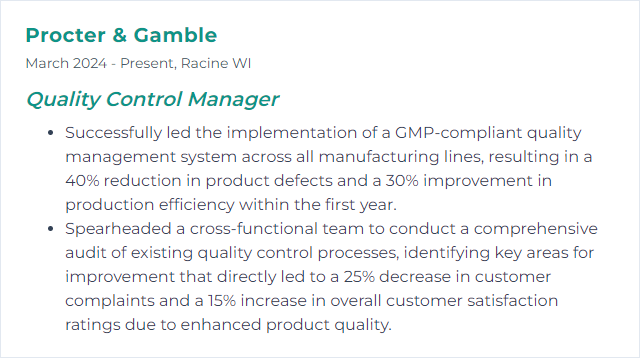
11. Auditing Techniques
Auditing techniques are the methods used to check whether a quality system works as intended—interviews, observations, sampling, and document reviews.
Why It's Important
Audits reveal blind spots, confirm control, and guide improvements before customers or regulators do it for you.
How to Improve Auditing Techniques Skills
- Stay current: Keep up with standards and sector-specific requirements that apply to your products.
- Risk-based planning: Focus on high-risk processes, top defects, and recent changes.
- Strong sampling: Use representative samples and follow evidence chains to real outcomes.
- Process audits: Go beyond checklists—trace inputs to outputs on the floor.
- Clear findings: Evidence-based, cause-oriented, and prioritized. Avoid vague language.
- Follow-through: Verify corrective actions and effectiveness. Re-audit where needed.
- Leverage tools: Use audit management software or structured templates for consistency and traceability.
How to Display Auditing Techniques Skills on Your Resume
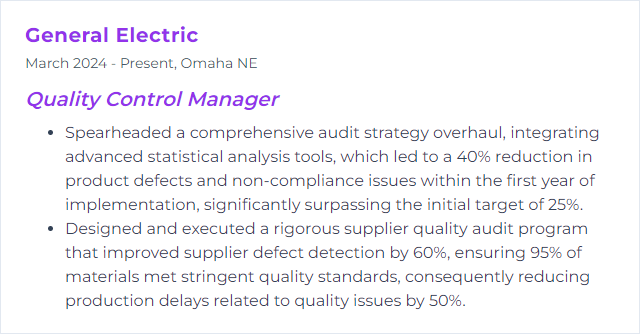
12. Risk Management
Risk management identifies, assesses, and controls threats to product quality, compliance, and business continuity.
Why It's Important
Fewer surprises, fewer losses. It keeps priorities straight when time and resources are tight.
How to Improve Risk Management Skills
- Set the scope: Define context, stakeholders, and risk criteria before you rate anything.
- Build a risk register: Likelihood, impact, detection, owners, and mitigations—kept alive, not dusty.
- Use proven methods: FMEA, bow‑tie analysis, hazard analysis, and control plans where appropriate.
- Targeted controls: Prevention first, then detection. Verify controls with data.
- Monitor leading indicators: Near misses, drift in process capability, training gaps—catch trends early.
- Review cadence: Periodic risk reviews tied to management review and changes.
- Culture: Encourage reporting and challenge assumptions. Reward early warnings.
How to Display Risk Management Skills on Your Resume
